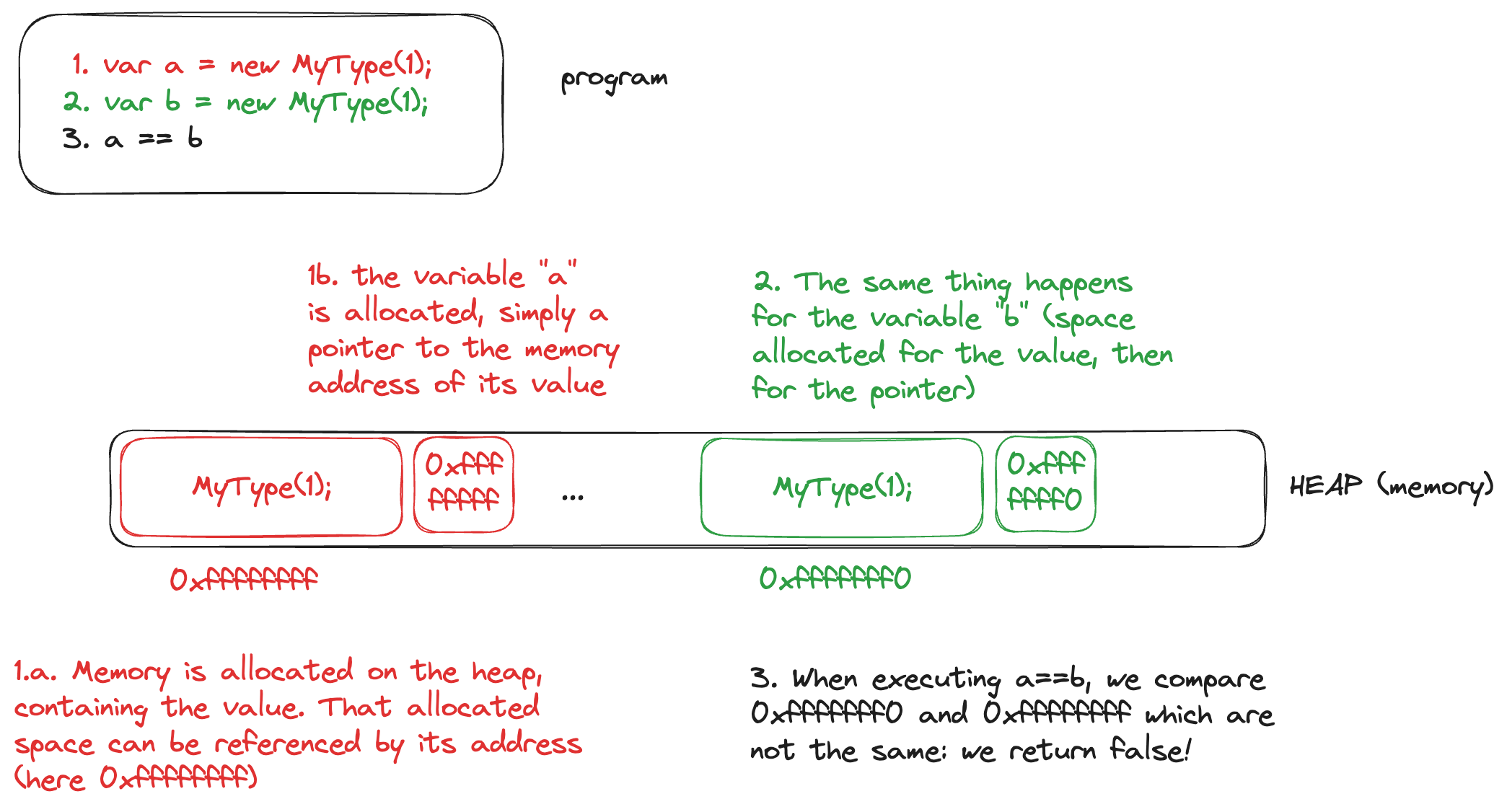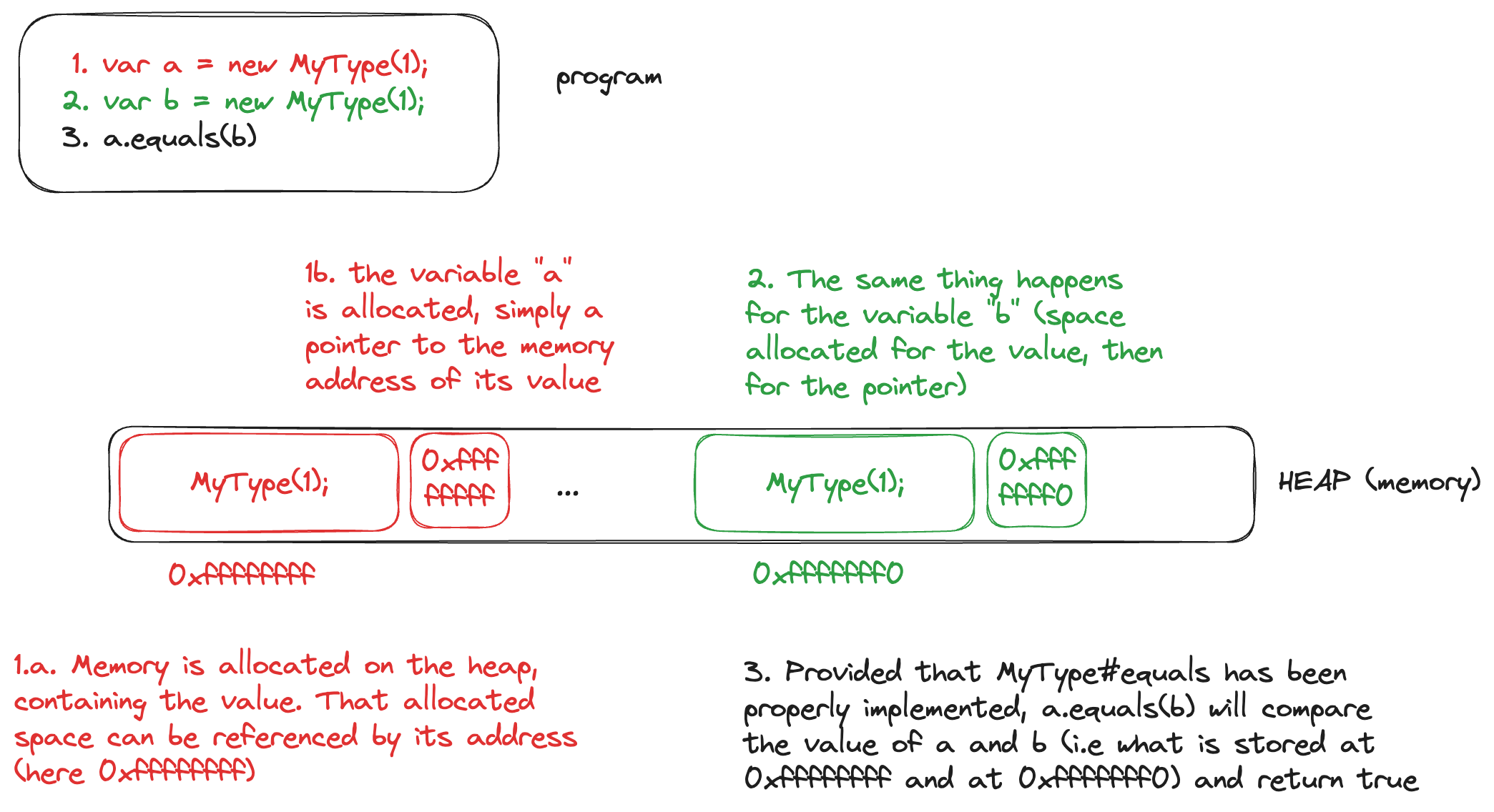Java was first releases in 1996. After almost 30 years and more than 20 successive iterations of the
language, it comes to no surprise that it has a few dusty corners and surprising quirks. One of them
is the difference between == and .equals. If you come from more modern languages, such as Go,
you might expect that new MyClass("a") == new MyClass("a")… but it is not the case!
Reference equals (==)
In Java == operates on references. This means that a == b will return true if and only if
both a and b point to the exact same object in memory. So, for example:
jshell> record MyType(int a) {}
| created record MyType
jshell> var a = new MyType(1)
a ==> MyType[a=1]
jshell> var b = new MyType(1)
b ==> MyType[a=1]
jshell> a == b
$5 ==> false
Here, while a and b have the same value, they point to two different objects so == returns
false. While this is not a perfectly accurate representation of what happens in memory, you can
imagine it so:

The equals method
In Java, java.lang.Object is a class, and is the root of the entire class hierarchy. This means
that every single class implicitly has extends Object even if it is not stated in the code.
Object defines an equals
method
that is therefore available on every single class. By default, this method uses the reference
equals. The big difference is that, being a method, you can override equals. And this is where you
can specify a behavior that compares the value instead of the reference. For example, the
default implementation of equals in records compares each field individually and returns true if
and only if fields are equal according to their respective equals method (or if they are both
null).
You can imagine it like this:

You may wonder, what if these fields are objects themselves? Won’t we end up calling equals all
the way down until we reach a class like Object that just uses the reference equals (==)? And
this is where we should talk about boxed types and primitive types.
Primitive and boxed types
Java distinguishes two types of types:
- primitive types
- object types
Primitive types are special in the sense that variables of a primitive type are not pointers to a
memory address. Instead, their value is directly stored on the heap when they are declared. This
means that two primitive values cannot share a value stored at the same place in memory… and
also that a == b will actually compare values when operating on primitive values! This is why the
following work “as expected”:
jshell> 1 == 1
$6 ==> true
jshell> 3.2 == 3.2
$7 ==> true
jshell> true == false
$8 ==> false
There are 8 primitive types in java: byte, short, int, long, float, double, boolean
and char. That’s it! Everything else is an object, and uses references.
The case of strings and enums
You might have noticed that strings are not primitive types. In fact, when you write var a = "abcd", you are using syntactic sugar: the compiler will transform it to var a = new String("abcd") for you. String is a subclass of Object, like any other class, and thus has an
equals method implemented for you. This is why you see the following:
jshell> var a = "abc"
a ==> "abc"
jshell> var b = "ab"
b ==> "ab"
jshell> var c = "c"
c ==> "c"
jshell> b+c
$19 ==> "abc"
jshell> a == b + c
$20 ==> false
jshell> a.equals(b+c)
$21 ==> true
What about enum then?
enum MyEnum {
A, B;
}
Since values of type MyEnum are necessarily A or B (you cannot do new MyEnum("A")!), then
using .equals or == is the same thing (both values of type MyEnum either have the same value
AND the same reference, or they have different values AND different references).
Conclusion
In Java, except if you are dealing with primitive types (or enums), you should always use equals,
unless reference comparison is what you’re looking for.
